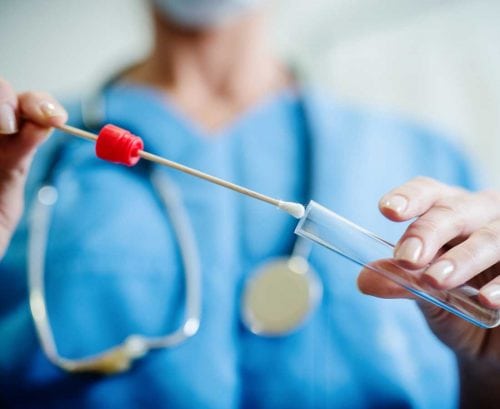
As novel coronavirus cases continue to increase around the world, some people are getting frustrated they can’t be tested. Healthy Food Guide looks at the recommended criteria for COVID-19 testing.
The World Health Organization has stressed that testing for COVID-19 and isolating confirmed cases is central to preventing infection, saving lives and breaking the chains of transmission of the disease.
In a speech on 16 March 2020 WHO director general Tedros Adhanom Ghebreyesus said the simple message for all countries is to ‘test, test, test’.
On the back of that advice, many people are wondering why testing, so far, has been mostly limited to travellers and their close contacts.
Social media comment sections are full of disgruntled people with coughs or sore throats complaining their GP turned them down for testing.
But what they may have missed is what Dr Ghebreyesus said next in his speech: “Test every suspected case.”
So, what counts as a suspected coronavirus case?
The WHO defines a suspected case as meeting one of three sets of criteria:
1. A person with acute respiratory illness, such fever and cough or shortness of breath, with no other possible cause, and a history of travel to, or residence in, a territory that has community transmission of COVID-19, within 14 days of the onset of symptoms
2. A person with acute respiratory illness who has been in contact with a confirmed or probable case of COVID-19 disease during the 14 days prior to the onset of symptoms
3. A person with severe acute respiratory infection who requires hospitalisation and has no other probable cause.
Why do some places test more people in the community?
The slightly tricky part is that it depends, to some extent, on what stage a country is at in the pandemic and what their capacity for testing is.
Some places, such as Italy, have widespread community transmission, while others, such as New Zealand, have a small cluster of cases that have all, so far, been traced to travellers, and their close contacts, from an affected territory.
In a press statement on 17 March, the WHO regional director for Europe, Hans Henri P. Kluge, explained the four scenarios of outbreak that impact the type of government response in a given country:
1. no case
2. first case
3. first cluster
4. first evidence of community transmission.
According to Dr Kluge, “Every single country must assess their own situation and context, including virus spread, measures in place and social acceptability, and adopt the most appropriate interventions.”
The fundamental actions that need to take place in every country are:
1. prepare and be ready
2. detect, protect and treat
3. reduce transmission; and
4. innovate and learn, while protecting vulnerable people.
The scenario level each country is at will dictate which intervention that government puts most emphasis on, he says.
So, in a place where there are no cases yet, the emphasis will be on preparing for coronavirus to arrive, whereas, in a place that has its first case or cluster, the emphasis will be on testing, tracing and treating cases, as well as measures to reduce transmission such as isolation.
Testing capacity varies from country to country
According to the WHO, more diagnostic testing kits are being produced daily to meet global demand.
“WHO has shipped almost 1.5 million tests to 120 countries. We’re working with companies to increase the availability of tests for those most in need,” Dr Ghebreyesus says.
The Republic of Korea has an incredible national testing capacity of 15,000 per day and is second only to Bahrain in the number of tests per million people conducted (around 5500 per million people).
As of 20 March, New Zealand had carried out 6000 COVID-19 tests, which works out at around 1244 per million people. New Zealand is currently able to carry out 1500 tests per day, director-general of health Ashley Bloomfield says. In New Zealand it is now up to the GPs to decide if they test, with the guidelines in mind. Some GPs have pointed out testing can take between 30 minutes to an hour, in some cases.
On 17 March, the US had run 125 test per million people, and New South Wales, Australia around 3314 per million people, according to Our World in Data.
Now, it’s important to know these are the number of tests performed, not the numbers of people tested, because in some instances a person might be tested more than once, when tests fail or produce a false negative.
Why don’t we just test everyone?
As you can see, testing around the world is targeted at relatively small numbers of people in the population.
In a Spinoff article, microbiologist Siouxsie Wiles points out COVID-19 testing requires collecting the right samples. And how this is done differs from person to person, depending on their symptoms.
Dr Wiles says this means people need to be trained to take the various types of samples, which can be done, but will take resources away from other areas of healthcare, research and lab testing.
She says commercial testing kits are limited and scientists worldwide are working on ways to test without having to use them, but we’re not there yet.
As more tests become available, testing will widen.
A further hurdle is the fact the same testing kits are used for detecting for influenza. And, as some countries are heading into flu season, demand on this limited resource will increase.
Earlier I mentioned false-negative results from testing. There are multiple reasons false negatives occur and require testing to be done again.
Two of them, that are most relevant to why we don’t just test everyone, are because the virus is either at such an early stage it can’t be detected, or a patient has no major respiratory symptoms, so there is not enough of it detectable in the patient’s nose or throat.
The risk is if a person has no symptoms and meets none of the other criteria for being a suspected case, testing them would potentially be a waste of resource, and may not pick anything up, even if they are infected.
Where community transmission has occurred, it’s especially important there are enough testing kits available to test the most vulnerable suspected cases such as the elderly and people with compromised immune systems.
So, what can individuals do to protect themselves and others?
If you meet the criteria for being a suspected case, then it is important you contact your healthcare provider by phone, rather than just turning up at a clinic. They will tell you if you need to be tested and what to do from there.
It is also vital for you to self-isolate for 14 days, and follow advice for handwashing, cough and sneeze etiquette, social distancing and not sharing eating and drinking utensils, linen and towels.
Of course, there are instances where a person can have coronavirus but shows no symptoms. Again, this is why it’s important to follow the advice below and take some personal responsibility in protecting yourself and others, especially if you have good reason to think you have been in contact with someone who is infected.
If you don’t meet the criteria for being a suspected or probable case but feel unwell, stay at home till your symptoms have well and truly gone. And while you self-isolate, behave as though you have COVID-19:
1. Minimise contact with other household members and avoid having visitors. It is okay to have family, friends or delivery drivers drop food off to you
2. Do not share eating and drinking utensils, towels or pillowcases with other people in your home. Wash any of these items thoroughly after use with soap and water before placing them in the dishwasher or washing machine (for linen and towels).
For everyone else, you can protect yourself and others by:
1. Covering coughs and sneezes with tissues you dispose of immediately and safely (if you don’t have a tissue, cough or sneeze into the crook of your arm, not your hands)
2. Avoiding touching your eyes, nose and mouth. If your hands are contaminated with the virus it can enter your body from these points
3. Avoiding spitting in public
4. Washing your hands for at least 20 seconds with water and soap and drying them thoroughly (ideally with disposable paper towels) before eating and food handling, after using the toilet, after coughing or sneezing, after wiping your nose or that of a child, and after looking after sick people
5. Using an alcohol-based hand sanitiser, if you can’t wash your hands with soap and water
6. Maintaining at least a 1 metre distance between yourself and anyone who is coughing or sneezing. If you have symptoms, keep your distance from others
7. If your symptoms worsen, contacting your health service early by phone rather than just turning up unannounced. Give them time and notice to make arrangements to keep you and others safe. In New Zealand, call Healthline on 0800 611 116
8. Staying informed on the latest developments in your area
9. Avoiding travel.
The bottom line for COVID-19 testing
Who gets tested and when will depend on a number of factors:
- The pandemic scenario where you live. If community transmission has occurred, testing is likely to be more widespread
- Whether you meet criteria for being a suspected case
- The amount and type of resources available in your country (which will, in part, depend on the level and nature of transmission.
Article sources and references
- WHO Director-General's opening remarks at the media briefing on COVID-19 - 16 March 2020. World Health Organizationhttps://www.who.int/dg/speeches/detail/who-director-general-s-opening-remarks-at-the-media-briefing-on-covid-19---16-march-2020
- Statement - Every country needs to take boldest actions to stop COVID-19. World Health Organizationhttp://www.euro.who.int/en/about-us/regional-director/statements/statement-every-country-needs-to-take-boldest-actions-to-stop-covid-19
- WHO Director-General's opening remarks at the media briefing on COVID-19 - 18 March 2020. World Health Organizationhttps://www.who.int/dg/speeches/detail/who-director-general-s-opening-remarks-at-the-media-briefing-on-covid-19---18-march-2020
- Global surveillance for COVID-19 disease caused by human infection with the 2019 novel coronavirus. World Health Organizationhttps://www.who.int/publications-detail/global-surveillance-for-human-infection-with-novel-coronavirus-(2019-ncov)
- Laboratory testing for coronavirus disease 2019 (COVID-19) in suspected human cases. World Health Organizationhttps://www.who.int/publications-detail/laboratory-testing-for-2019-novel-coronavirus-in-suspected-human-cases-20200117
- How many tests for COVID-19 are being performed around the world? Our World in Datahttps://ourworldindata.org/covid-testing
- The updates on COVID-19 in Korea as of 18 March. Centres for Disease Control and Prevention Koreahttps://www.cdc.go.kr/board/board.es?mid=&bid=0030&act=view&list_no=366586&tag=&nPage=1
- Coronavirus Testing: Criteria and Numbers by Country. Worldometerhttps://www.worldometers.info/coronavirus/covid-19-testing/
- Coronavirus cases have dropped sharply in South Korea. What’s the secret to its success? Sciencehttps://www.sciencemag.org/news/2020/03/coronavirus-cases-have-dropped-sharply-south-korea-whats-secret-its-success
- FACT SHEET FOR HEALTHCARE PROVIDERS. CDC - 2019-nCoV Real-Time RT-PCR Diagnostic Panel Updated: March 15, 2020. Centres for Disease Control and Preventionhttps://www.cdc.gov/coronavirus/2019-ncov/downloads/Factsheet-for-Healthcare-Providers-2019-nCoV.pdf
- Siouxsie Wiles: How testing for Covid-19 works. The Spinoffhttps://thespinoff.co.nz/science/18-03-2020/siouxsie-wiles-how-testing-for-covid-19-works/
www.healthyfood.com










